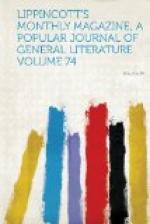E.Y.
UNVEILING KEATS’S MEDALLION.
I have just returned from a little ceremony of which I think that the readers of these pages will be pleased to have some permanent record—the uncovering of the medallion portrait of Keats, which Mr. Warrington Wood, the well-known sculptor, has generously given for the purpose of adorning his tomb. I have recorded in a previous number of this Magazine the steps which were taken last year for putting the poet’s celebrated grave and gravestone in a proper state of repair, and the singular circumstances that showed how on both sides of the Atlantic a similar thought had with truly curious simultaneousness occurred to the lovers of the poet’s memory. The very striking scene which took place to-day marked the completion of the purposes which were then inaugurated.
A printed notice had invited all English and Americans in Rome, interested in the subject, to attend at the English cemetery at three o’clock, the day having been fixed by the fact that it was the anniversary of the day of Keats’s death. It was also, as it happened, the second day of our boisterous and rollicking Carnival, and those who attended had to absent themselves from the attractions of the Corso. Nevertheless, the gathering was a large one, and the contrast between the scene passing in that remote and quiet corner of old Rome under the cypresses and in the shade of the pyramid of Caius Cestius, and that which was at the same time being enacted in the Corso, was about as great as can well be conceived. We had it all to ourselves. With the exception of the coachmen, who remained lazily dozing on the boxes of the carriages which had brought us from the living Rome of to-day to this far-away spot, there was not a soul on the ground save English and Americans.




